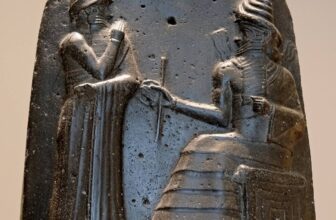Its About A Change And Who The Goddess is In Favor To Win
The Evidence of David and Goliath
David and Goliath: History, Evidence, and Biblical Significance
The story of David and Goliath is one of the most well-known biblical accounts, often symbolizing the triumph of the underdog against overwhelming odds. But is there any historical or archaeological evidence to support this event? Was David a real historical figure? Did Goliath exist, and were there giants in the Bible? This article explores these questions in depth, analyzing biblical texts, historical accounts, and archaeological findings.?
The story of David and Goliath is recorded in 1 Samuel 17 in the Old Testament. According to the account, David, a young shepherd, faced the Philistine warrior Goliath in single combat. With just a sling and a few stones, David struck Goliath on the forehead, felling him before cutting off his head with Goliath’s own sword.
From a historical and archaeological standpoint, there is no definitive physical evidence that the battle between David and Goliath took place as described. However, several pieces of circumstantial evidence suggest that elements of the story may be based on real historical events:
- The Existence of King David – Archaeological discoveries, such as the Tel Dan Stele, an ancient stone inscription dating back to the 9th century BCE, provide evidence that a historical King David existed. The inscription mentions the “House of David,” indicating that a dynasty bearing his name was known in the region.
- The Philistines – The Philistines were a real people who lived in the ancient land of Canaan (modern-day Israel and Gaza). Archaeological digs in cities like Ashkelon and Gath (Goliath’s supposed hometown) confirm their presence and sophisticated culture.
- Goliath’s Name – Ancient inscriptions found at Gath mention names similar to “Goliath,” suggesting that such names were in use at the time.
While these findings do not directly prove the battle occurred, they lend credibility to the existence of David and the Philistines, making the story more historically plausible.
Is David and Goliath Based on a True Story?
The story of David and Goliath may be a mix of historical events and theological symbolism. Many scholars believe that the account, whether literal or embellished, serves to highlight the theme of divine providence, how faith in God can help an individual overcome seemingly insurmountable obstacles.
Some historians argue that David’s battle against Goliath might have been an exaggerated account of a real conflict. In the ancient world, single combat between champions was a known military practice, used to decide the outcome of battles without massive bloodshed. If a young warrior named David fought and defeated a particularly formidable Philistine, the story may have been passed down and enhanced over time.
Others suggest that the story could be an allegory, designed to inspire faith in God’s power. Whether or not the duel happened exactly as written, the story has had an enduring impact on literature, art, and culture for thousands of years.
Why Did David Hit Goliath?
David’s decision to strike Goliath was strategic. Goliath was a heavily armored warrior, expecting hand-to-hand combat with swords or spears. Instead, David, skilled with a sling from his days as a shepherd, used an unconventional approach. His sling was not a mere child’s toy but a powerful weapon capable of hurling stones at lethal speeds, often compared to the stopping power of a modern handgun.
David aimed for Goliath’s forehead, the one vulnerable spot left unprotected by his armor. This choice of attack demonstrates tactical intelligence, as well as faith that God would guide his hand to victory.
How Many Stones Did It Take David to Hit Goliath?
The Bible states that David picked up five smooth stones from a brook before facing Goliath (1 Samuel 17:40). However, he only needed one stone to strike Goliath and bring him down.
Many have speculated why David took five stones instead of just one. Some theories include:
- Preparedness – David was simply being cautious and ready for multiple attempts.
- Goliath’s Brothers – Some interpretations suggest Goliath had four brothers, and David may have been ready to fight them if needed (2 Samuel 21:15-22 references other Philistine giants).
- Symbolism – The number five may have symbolic significance in biblical texts.
Regardless of the reason, David’s first and only shot was enough to secure his victory.
How Many Times Did David Fight Goliath?
David fought Goliath only once in the biblical narrative. However, this was not his only battle against the Philistines. As King of Israel, David led numerous military campaigns against the Philistines and other enemies of Israel.
Some confusion arises because later in 2 Samuel 21:19, there is a mention of another battle where a warrior named Elhanan kills a Philistine giant. Some scholars believe this could be a later scribal error or a retelling of the same event, while others suggest that David’s victory was later attributed to another warrior.
Did Giants Exist in the Bible?
Yes, the Bible mentions giants in multiple passages. The term “giant” is often associated with the Nephilim, the mysterious beings referenced in Genesis 6:4, as well as other formidable warriors, such as the Rephaim, Anakim, and Emim mentioned in the Old Testament.
Goliath is described as being six cubits and a span tall (1 Samuel 17:4), which is roughly 9 feet 9 inches (about 3 meters) tall according to ancient measurements. Some manuscripts, such as the Dead Sea Scrolls and the Septuagint, give his height as four cubits and a span (about 6 feet 9 inches), which, while still tall, is within the range of exceptionally large humans.
Whether Goliath was a true giant or simply a man of unusual height and strength, the Bible consistently describes individuals of great stature who were feared in battle.
The story of David and Goliath continues to capture the imagination of people around the world. While definitive archaeological proof of the battle remains elusive, evidence of King David, the Philistines, and references to giants in the Bible lend credence to the possibility that the story is based on real historical events.
Whether read as a literal historical account or a powerful allegory of faith, strategy, and divine intervention, David’s triumph over Goliath remains a timeless symbol of courage in the face of overwhelming odds. The legacy of this legendary encounter continues to inspire individuals across cultures, reinforcing the belief that even the smallest among us can achieve greatness with determination, faith, and wisdom.




